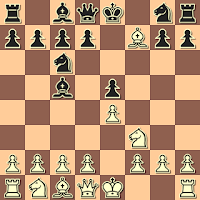
[Continuing from the previous post]
perrypawnpusher - keshavdmutkule
Giuoco Piano Thematic Tournament, Chess.com, 2016
16...Rf8 17.Qh4 Bd7 18.Bg5 Qf7
Black moves his heavy pieces to the f-file.
I was not too concerned. I had no plans to open either the e- or the f-file. I planned the usual pressure on f6 while I waited.
19.a3 c5
Here comes some of the pressure against White's center. I think my opponent would do better to keep things dynamic, however, rather than exchange pawns, as he does on the next move.
20.Rad1 cxd4 21.Rxd4 Bc6
If Black is thinking about moving into an endgame with Bishops-of-opposite-colors, then he is probably not worried about dropping a pawn. Such endings are notoriously drawish, even with a difference of 1, 2, or even (sometimes) 3 pawns. Still, I thought I had learned enough about them to prevail.
22.Rxd6 Rad8
This move overlooks something. Stockfish 7, after the game, suggested that 22...Nd7 led to an equal game.
23.Rxd8 Rxd8 24.e5
Yes.
24...Re8 25.exf6 Rxe1+ 26.Qxe1 gxf6 27.Bh4 Qg6
28.Qg3
Giving my opponent what he apparently wants - with Queens off of the board we will have a "safe" endgame.
I was getting dizzy trying to analyze the many things his Queen and my Queen could do in this position, so I finally decided to take them off of the board.
28...f5
A bit of humor here - who will be the one to swap Queens? I think the sharper choice was 28...Kf7, as 29.Qc7+ would have been too crazy for me, and 29. Qxg6+ hxg6 is one step closer to splitting the point. Also, advancing the pawn, this move and next, puts it at risk. The way things are, Black might be able to afford being 2 pawns down, but probably not 3.
29.b3 f4 30.Qxg6+
I can't remember why I didn't play 30.Qxf4, but I guess it was to avoid 30...Qb1+, etc. The f-pawn will fall, anyhow.
30...hxg6
White will soon be 3 pawns ahead. Will it be enough? I think so.
31.Bg5 Bd5 32.c4 Be6 33.Kf2 Kg7 34.Bxf4 Kf6
Black's defense will be based upon putting his pawns on the same colored squares as his Bishop, and then constructing a blockade of White's advancing pawns.
35.Bc7 b5 36.cxb5 Bxb3 37.Ke3 Ke6
For now, Black's b-pawn will hold off White's two Queenside pawns. However, some time in the future - when White's pawns have advanced to a5 and b6 - he will have to guard against the sacrifice a5-a6 which will let the b-pawn advance toward promotion.
In the meantime, White will create two passed pawns on the Kingside. It will be difficult for Black's Bishop to guard against threats on both sides of the board.
38.Kf4 Kd5
Going after White's a-pawn, but the King needed to stay and play defense on the Kingside.
39.h4 Kc5 40.b6 Bc4 41.Ke5
Black's King will not be able to get back to the Kingside in time, now. White will create a passed pawn that will cost Black his Bishop - and then the game.
41...Bf1 42.g4 Be2 43.h5 gxh5 44.gxh5 Bd3
45.h6 Kb5 46.Kf6 Bh7 47.Kg7 Bf5 48.h7 Bxh7 49.Kxh7 Ka4 50.f4 Kxa3 Black resigned
The extra pawn will promote.









































